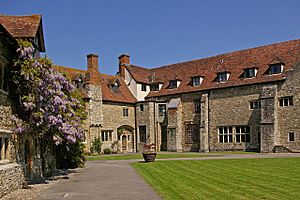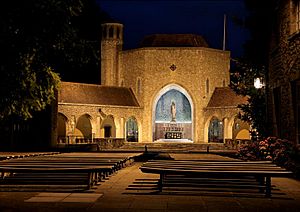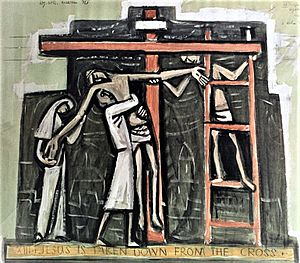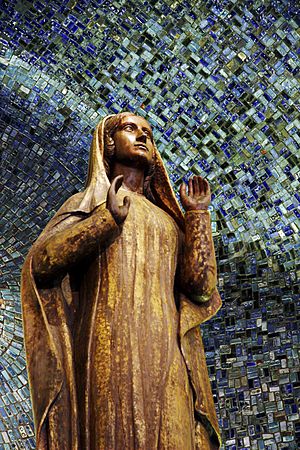Aylesford Priory facts for kids
Aylesford Priory, also known as "The Friars", is a special place with a long history. It was started in 1242 when a group of religious people called Carmelites came to England. They had traveled all the way from Mount Carmel in the Holy Land. A crusader named Richard de Grey helped them. He gave them some land in Aylesford, a town in Kent, to build their home.
Contents
Aylesford Priory: A Look at Its History
The Carmelites first arrived in Kent in the 1200s. Richard of Wendover, who was a bishop in Kent, officially recognized their new home at Aylesford. This place became very important. It was where the first big meeting of the Carmelite order outside the Holy Land took place. At this meeting, the Carmelites decided to change their way of life. They went from being hermits (people who live alone) to becoming mendicant friars. This meant they would travel and rely on donations.
What Happened During the English Reformation?
During the English Reformation, a big change in England's religious history, the Carmelites had to leave Aylesford Priory in 1538. For the next 400 years, the buildings were used for different things. At one point, it was even a fancy, large house.
In 1930, a fire damaged the buildings. During the repairs, many of the original old features of the priory were discovered! Then, in 1949, the property was put up for sale. This was a great chance for the Carmelites to buy back their original home. They wanted to use it again for its first purpose: a place of worship and prayer.
Building the Shrine at Aylesford
After buying back the priory, more restoration work began. There were also plans to build a new Shrine. Construction started in 1958. People became more interested in "The Friars" again after the difficult war years. The first leader, Father Malachy Lynch, was a very inspiring person. He encouraged everyone with the words: "Courage to Build Anew." The completed Shrine was officially opened in 1965. Important religious leaders, like Cardinal Heenan and Archbishop Cyril Cowderoy, were there for the special event.
Amazing Art at The Friars
The Friars is home to many beautiful and modern religious artworks. You can see sculptures, paintings, stained glass windows, and even ceramic pieces here.
Sculptures at Aylesford Priory
Philip Lindsey Clark came from a family of sculptors. He created art for many places, including Westminster Cathedral and war memorials. As the head of the Religious Artist Guild, he brought two other talented artists to The Friars: Adam Kossowski and his own son, Michael Clark.
Michael Clark is famous for his religious sculptures. He made the small statues you can see above the doorways in the Courtyard. He even won an award, the Otto Beit Medal for Sculpture, for his statue called "The Glorious Assumption."
Adam Kossowski was born in Poland in 1943. He studied art in Cracow and Warsaw. Adam started working at Aylesford in 1950. His first major project was for Father Malachy Lynch, the leader of Aylesford Priory. It was a seven-panel painting called History of the Carmelites of Aylesford.
Adam's first large ceramic project was also for Aylesford: a Rosary Way. He wasn't sure if he was the right person for the job. But Father Malachy told him, "Adam, I am sure Our Lady has sent you here for that purpose." After he successfully finished the Rosary Way, Adam received his biggest ceramic project ever: The Vision of St. Simon Stock.
Adam Kossowski worked with the Aylesford Carmelites from 1950 to 1972. During this time, he created about one hundred different art pieces for them. These included works in ceramic, painting, mosaic, wrought iron, and stained glass.
Beautiful Stained Glass Windows
Moira Forsyth was one of the best stained glass artists of her time. She gave the "Flos Carmeli" window as a personal gift to the Cloister Chapel. She gave it to celebrate becoming Catholic in 1957. "Flos Carmeli" means "Flower of Carmel" and is the first line of a hymn the Carmelites sing to Our Lady.
Dom Charles Norris designed the windows in the Relic Chapel and the side chapel. He used a special stained glass style called ‘dalles de verre’. In this style, colored glass pieces are chipped into shape and then set into a resin material, like a mosaic.
Adam Kossowski also designed some of the windows in the main part of the chapel.
Hartley Wood Glass from Sunderland made several other windows. These include the diamond-patterned windows in the Choir Chapel, the windows in the tribune of the Relic Chapel and St. Joseph’s Chapel, the "Spring of Faith" windows in St. Anne’s Chapel, and the gold, brown, and orange windows in the old Convent Chapel.
The Shrine at Aylesford
Adrian Gilbert Scott was the architect who designed the Shrine. His family was famous for building many Gothic-style buildings in Britain. His older brother was Giles Gilbert Scott, and their father was George Gilbert Scott Jr..
The old medieval buildings at Aylesford include the Prior’s Hall, two parts of the Cloisters, the Cloister Chapel, and the Courtyard. The Pilgrims’ Hall is also in the Courtyard, right next to the River Medway.
Behind the Shrine, you can find the Rosary Way, which is close to the peaceful Peace Garden.
Old Barns at the Priory
Near the main entrance, there are two old barns that have been restored. One of these barns, which dates back to the 1600s, now holds the Tearoom and Giftshop.
Aylesford Pottery
Aylesford Pottery is located right at the Priory. It was started by David Leach in 1954. Today, it is still a working pottery where artists create beautiful pieces. It also has a showroom where you can see their work. Aylesford Pottery is one of the few places in southeast England that still makes handmade pottery. They create both thrown and hand-built ceramics, and also take on big projects for buildings. Two master potters, Alan Parris and Billy Byles, run the pottery today.
Important Burials at Aylesford
Some important people are buried at Aylesford Priory:
- Mazilia (or Marcelin/Mascelin) de Braci, who was the wife of William de Cantilupe (died 1239)
- Simon Stock
- Adam Kossowski






